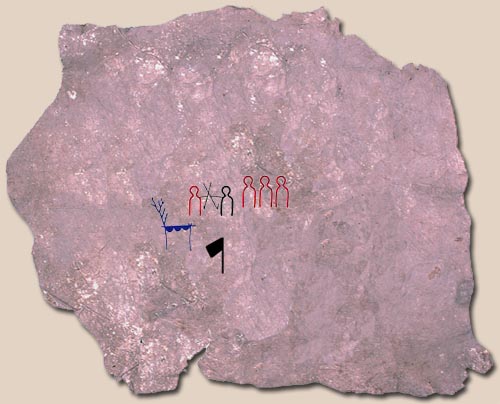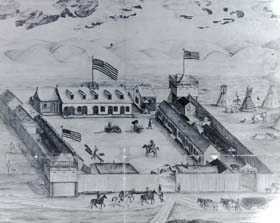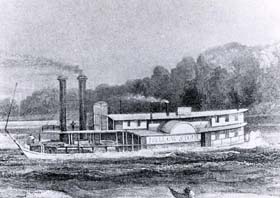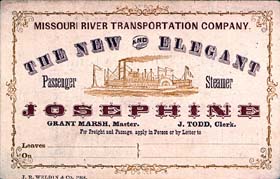|
Lesson
2
The Rise and Fall of the Fur Trade
|
| |
|
Timeline |
|
| 1802 |
| Fort
Aux Cedres built |
| 1806 |
| Lewis
and Clark revisit South Dakota |
| 1812-1815 |
| United
States and Great Britain are at war |
| 1823 |
| Arikaras
attack fur traders |
| 1832 |
| Fort
Pierre built |
| 1851 |
| Eight
tribes meet with United States at Fort Laramie |
| 1858 |
| Yanktons
sign treaty with United States |
| 1861 |
| Dakota
Territory formed |
| 1865 |
| Red
Cloud’s War begins |
| 1868 |
| Fort
Laramie Treaty signed |
| 1874 |
| Custer
leads expedition to Black Hills |
| 1877 |
| Black
Hills opened to settlement |
|
The fur trade
along the Missouri River changed. Beaver and other small animal pelts
were less important. Traders wanted buffalo hides and robes. They also
wanted buffalo tongues. People on the East Coast ate them as
delicacies. Thousands of pounds of buffalo tongue sailed down the
Missouri River each year. The Tetons, or Lakotas, made good profits
from this trade. Their camps were close to the buffalo. They were also
close to the trading posts. They grew rich with trade goods—rifles, food, and tools.
Yet the fur
trade also brought conflict. Indian nations fought over it. American
traders did too. The two groups also fought each other. Everyone
wanted to control this
booming
business. The United States government built a military post. It was
near Council Bluffs, Iowa. Soldiers there kept an eye on the fur
trade.
Trouble broke
out four years later. It was 1823. The place was near the mouth of the
Grand River. The Arikaras fired on a group of American traders.
Soldiers from Fort Atkinson marched north. They were going to punish
the Arikaras. Fur traders and Teton warriors joined with the army. The
Arikaras slipped away in the night. Their village was burned.
|
|
Soon the United States sent an official
commission
to the area. These men met with the Indian tribes. They negotiated
with the leaders. They asked them to sign treaties of goodwill.
Leaders from the Arikara, Cheyenne, Yankton, and Yanktonnais
tribes signed. Some Teton leaders did too. These were the first
treaties between the United States and these Indian nations.
|

Winter Count
|
|
|
The fur
trade kept growing. Such
legendary
fur traders as Jedediah Smith and Hugh Glass
crisscrossed the prairie. They met to trade with Indians and other
trappers each year. Such a meeting was called a rendezvous. One
was held on the James River near what is now Redfield. Here the
traders and Indians traded furs and news. They also danced, sang,
and feasted together.
|
|

Photo courtesy of South Dakota State
Historical Society
|
A new company
came into the Missouri River country. It was the American Fur
Company. Pierre Chouteau, Jr., built a fort for the company.
It was Fort Pierre at the mouth of the Bad River. The year was 1832.
Fort Pierre became the most important trading post in the region. It
was the first permanent American settlement in the state. It was
more than a little cluster of cabins. Fort Pierre had its own farm
and a blacksmith shop.
|
|
|
|
|
Pierre
Chouteau, Jr., had sailed up the Missouri River in a steamboat. It
was a new kind of boat driven by steam power. It was called the Yellowstone. This steamboat was
loaded with trading supplies. It sailed all the way from Saint Louis
to central South Dakota. The Yellowstone was the first
steamboat on the Missouri River. A steamboat could go faster than
keelboats or bullboats. It could go longer distances. It could carry
more cargo.
|

Photo courtesy of South Dakota State
Historical Society
|
|

Photo courtesy of South Dakota State
Historical Society
|
Steamboats
also brought visitors to South Dakota. Artists and writers steamed
up the river. They came to see the Indian way of life. They wanted
to learn about the Great Plains. Artists George Catlin and Karl
Bodmer came to paint the Tetons and the Mandans. John James
Audubon came to paint the birds and the animals.
Missionaries came as well. Father
Pierre De Smet worked among the Yanktons. Later this Jesuit priest
worked with the Tetons. Presbyterian minister Stephen Riggs came
to look at the country.
|
|
|
Sadly,
visitors and traders brought more than trade goods. They brought
more than curiosity or religious ideas. They did not know it, but
they also brought smallpox. This disease was deadly. It spread
quickly through the Arikara villages. Many, many people died. The
Arikaras were hit hard. So few people were left that they joined
the Mandans in North Dakota.
Soon the
buffalo herds began to
dwindle.
There were no more furs to trade.
|
| Vocabulary |
|
| booming (adj.), growing fast
commission (n.), a group of people sent to do a job
dwindle (v.), to get smaller
|
legendary (adj.), being famous or a part of an important
old story
missionaries (n.), people who teach their religion to
others
|
|
|